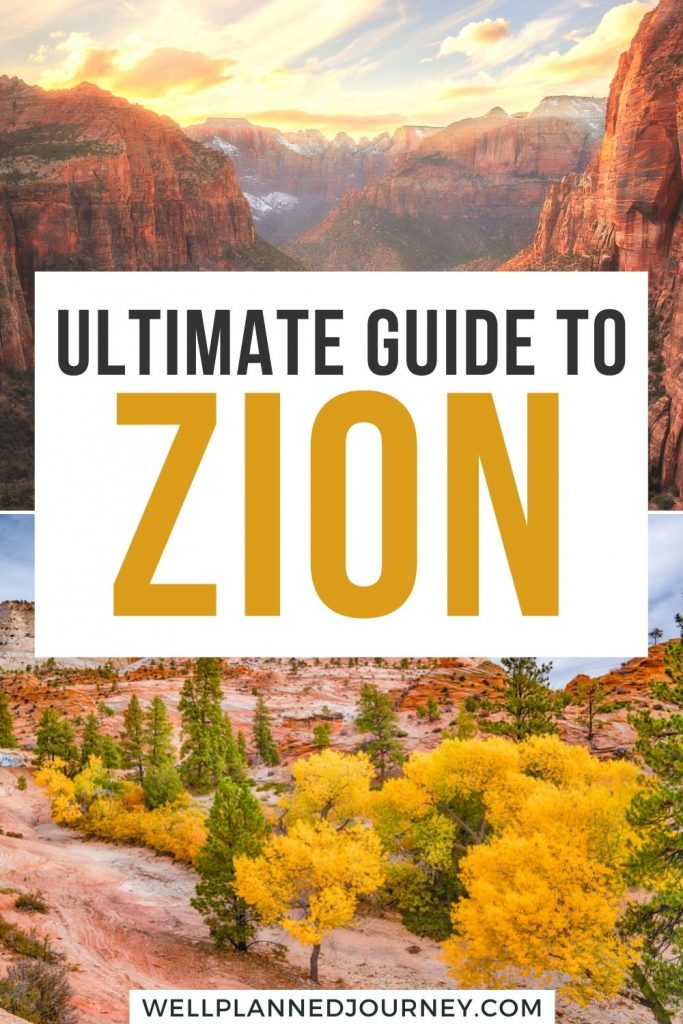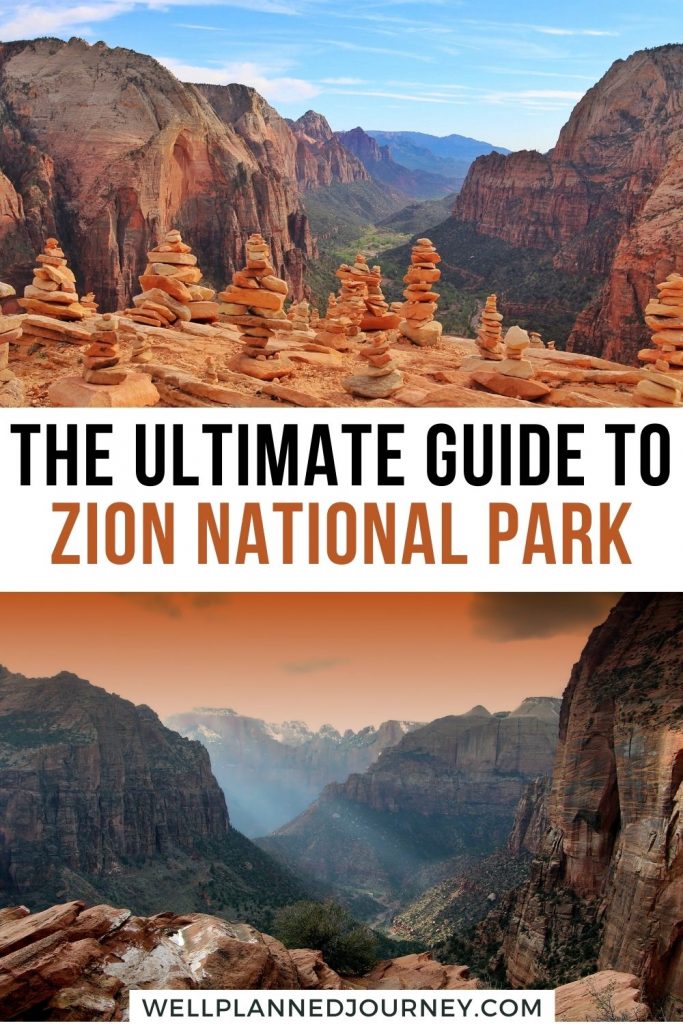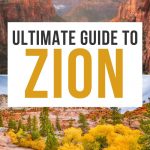Are you planning a trip to Zion National Park, but don’t know where to start?
As one of the most visited national parks in the country, there’s no shortage of incredible things to see and do. But how do you pick what to do in a short amount of time?
This guide to Zion National Park covers all the best things to do in the park with itinerary recommendations. Plus, I’m sharing tips on where to stay and getting around the park.
Let’s dive in and start planning your trip to Zion National Park!
Looking for more ideas for your trip to Zion National Park? Don’t miss these helpful posts!
- Hiking the Observation Point Trail in Zion
- The Best Time to Visit Zion National Park
- 3-Day Zion and Bryce Canyon Itinerary
- 8-Day Utah National Parks Road Trip Itinerary
This post may contain affiliate links, where I may receive a small commission at no additional cost to you. Read more in this disclosure policy.
Zion National Park At-A-Glance
Before diving in, here are a few highlights to help you plan your trip:
- Best Time to Visit: Spring or Fall are the best times to visit thanks to mild weather, perfect for hiking. Avoid crowds by visiting in March or November, on either end of peak season.
- Where to Stay: If you’re looking to stay in the park, your best option is Zion Lodge. If you’re looking to stay outside the park, I highly recommend either Cliffrose Lodge or Driftwood Lodge in Springdale.
- How to Get There: The closest airports are in Las Vegas (3 hours away) or Salt Lake City (4.5 hours away). Use Expedia to browse flights and find the best price.
- How to Get Around: Zion National Park requires visitors to take the free shuttle from Spring to Fall. However, you’ll still need your own car to get to Zion. Use Expedia to browse deals on rental cars or rent an RV or campervan with Outdoorsy!
- Best Self-Guided Tour: My favorite way to learn more about the park is with GyPSy Guides, a narrated self-guided tour perfect for road trips and scenic drives. The Zion & Bryce Canyon Guide and the Utah “Mighty 5” Bundle both provide incredible commentary and detail about the history and geology of these parks.
- Don’t Forget: Be sure to get an America the Beautiful National Park Pass ahead of time. This $80 pass is valid for 12 months and get you into all 400+ national park sites (including Zion!).
Why You Should Visit Zion National Park
Established in 1919, Zion National Park was the first of Utah’s “Mighty 5” national parks. To this day, it’s still the most popular park in Utah, with roughly 4.5 million visitors per year. There must be a reason everyone is visiting Zion?
Well, it might have to do with the breathtaking canyon slowly carved out by the Virgin River. It might also have to do with the layered red rocks complemented by unique greenery.
But it definitely has to do with the plethora of once-in-a-lifetime hikes.
Zion National Park has hikes for every skill level, from the paved Riverside Walk to the strenuous Observation Point. The two most famous hikes in the park are Angel’s Landing and The Narrows.
Angel’s Landing navigates 1,000-foot drop-offs with chains bolted into the rock wall. The Narrows allows you to wade through the knee-deep Virgin River.
Zion is also a popular park to visit on a Utah road trip. It’s often paired with the Grand Canyon, Bryce Canyon National Park or Grand Staircase-Escalante National Monument.
Read More: 3-Day Zion to Bryce Canyon Road Trip
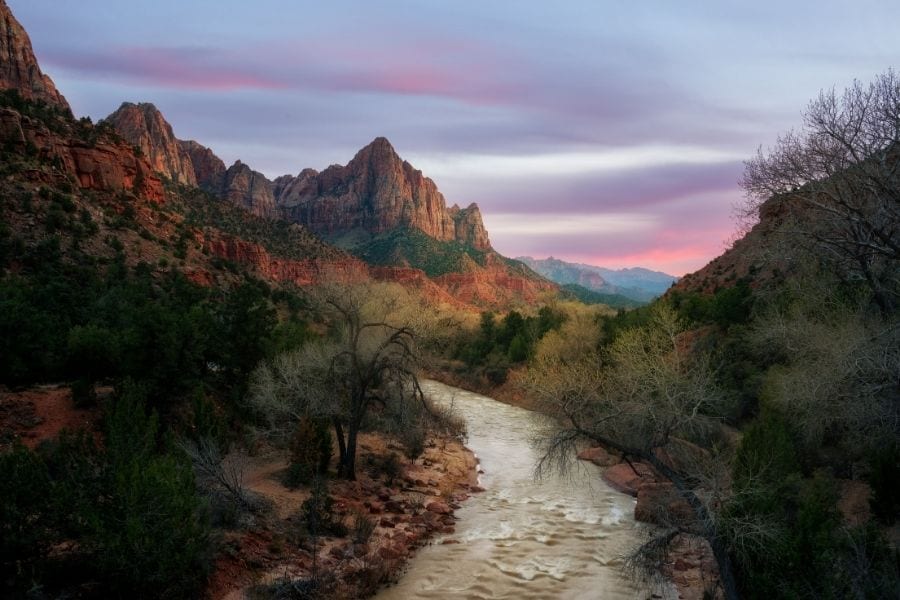
Best Time for Visiting Zion National Park
At lower elevations than the other Utah national parks, Zion is milder year-round. This means milder winters with less snow and pleasant shoulder seasons.
But don’t get me wrong, Zion National Park can get hot, often over 100 degrees in the peak summer months.
The hot summer months are also peak visitation months. Peak season at Zion National Park is May through September. The best time to visit Zion National Park is either April-May or September-October.
While most hikes are accessible year-round, hiking The Narrows requires some extra consideration. Water levels are too high to hike in the spring.
Most years, The Narrows is open by late May. By fall, the water temperatures begin to drop, making the hike unpleasant. Most visitors choose to hike The Narrows in the summer.
Zion National Park stays open year-round, allowing you to hike in the off-season. While the park doesn’t see heavy snow, some trails are icy and require traction equipment to navigate.
Want to know the best things to do in Zion each month? Check out this guide on the best time to visit Zion National Park.
Getting Around Zion National Park
You’ll need a vehicle to get to Zion, approximately 2.5 hours from Las Vegas airport and 4.5 from Salt Lake City airport. Many visitors choose to take a road trip by also visiting other nearby parks, like Bryce Canyon National Park.
Are you visiting multiple national parks in the next year? The America the Beautiful National Park Pass gets you into 400+ national park sites, including all 63 national parks, for 12 months!
Get your national park pass ahead of time for only $80.
While you need a car to get to Zion, in peak season you won’t be able to drive your car through the park. In 2000, Zion National Park implemented a free shuttle system to reduce traffic congestion.
The shuttle starts at the visitor center and runs to the end of Zion Canyon Scenic Drive at the Temple of Sinawava. The shuttle stops at all major trailheads and runs every 10-15 minutes.
Because the park requires all visitors to take the shuttle, it can get crowded. On a summer afternoon, you can expect to wait an hour to catch the shuttle at the visitor center.
Important Tip
Get to the park early. Try to get one of the first few shuttles into the park (between 6 and 7 am). This will ensure you’re spending your time hiking instead of waiting in line.
The park service also runs a shuttle from the visitor center through Springdale. With 9 stops, it’s easy to commute from your accommodations to the visitor center.
But one note: the Springdale shuttle doesn’t start running until after 7 am. If you’re trying to get into the park early, I recommend either driving and parking at the visitor center or walking (if you’re close enough to do so).
I use Expedia to find the best flight prices and compare routes. Once you find your flight, you can book directly through Expedia to save money, but still enter your frequent flyer numbers to get points!
If you need a rental car, I also recommend using Expedia to find the best deals across brands like Avis, Hertz, Enterprise, Budget, and more.
Where to Stay Near Zion National Park
This interactive map can also help you search all the available hotels and rental properties near Zion National Park! Simply scroll and click the map below to see what is available!
Springdale
You can’t beat the convenience of Springdale, just outside of the southern park limits.
Springdale offers a wide range of accommodations, from motels to luxury resort-style rooms. There are also lively restaurants, breweries, and bars throughout.
For those who want to explore Zion National Park, without roughing it, Springdale is the place to be.
Because of its proximity to the park, visitors should book 6 months in advance, as rooms will fill up.
Whenever I stay in a hotel, I like to book through Hotels.com. Oftentimes they have discounted or secret rates to book hotels at half price.
If you’re looking for a more luxurious hotel, I recommend Cliffrose Lodge – a short walk to the visitor center and dining in Springdale.
If you’re looking for something more affordable, I recommend the Driftwood Lodge.
Zion Lodge
Zion has one in-park lodge. Zion Lodge has cabins, hotel rooms, and suites, plus an on-site restaurant and cafe. Like most national park lodges, you’ll need to book far in advance. Reservations for Zion Lodge open up 13 months in advance.
Unlike other visitors to the park, guests of Zion Lodge are allowed to drive their car through the park to reach the lodge. The lodge also allows you to walk to trailheads like Lower Emerald Pools.

Camping
Zion National Park has 3 in-park campgrounds: Lava Point, South, and Watchman.
Lava Point is open from May through September and is located in the Kolob Canyons part of the park, roughly 1.5 hours away from the main visitor center. Campsites here are primitive and available on a first-come, first-served basis.
Watchman and South campgrounds are ¼ and ½ miles from the visitor center, respectively.
Watchman Campground
This campground offers 190 campsites, restroom facilities, and drinking water. Watchman also accepts reservations via Recreation.Gov.
Make a reservation 6 months in advance, as the campground stays at capacity during peak season. A standard tent-only campground is $20 per night.
I like to have solidified travel plans, so I recommend reserving Watchman Campground. You’ll have security in your accommodations further in advance.
And Watchman Campground is also closer to Springdale if you want to walk to town for a burger and a beer.
South Campground
South Campground offers 117 campsites, also with restroom facilities and drinking water. Unlike Watchman Campground, South Campground is available for reservation on a 14-day rolling basis through Recreation.Gov.
Tent-only campsites are $20 per night.
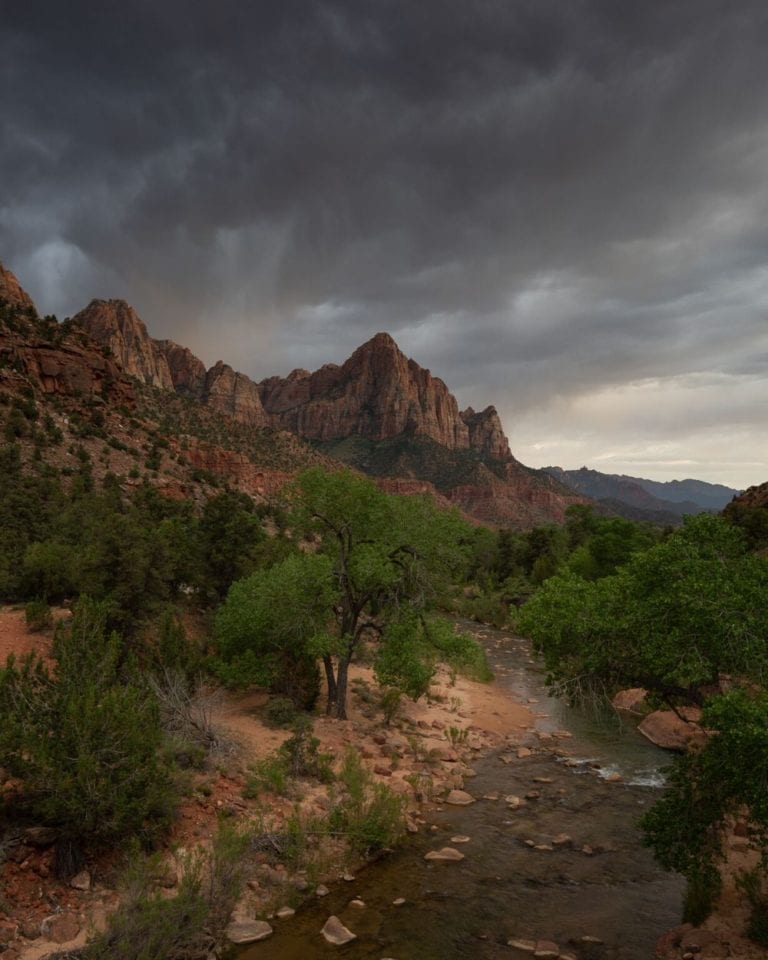
Backpacking
Zion also has backcountry trails that allow overnight camping. Permits are required and can be reserved 3-months out.
Since I haven’t explored Zion’s backcountry myself, I’ll let my favorite backpacking blog, Clever Hiker, tell you more about it. They recommend two backcountry treks in Zion National Park: Zion Traverse and The Narrows Top-Down.
Don’t miss the best of Utah’s national parks on your upcoming trip! This free, printable Utah national park road trip itinerary covers all the best points of interest in all 5 Utah parks, plus bonus tips on where to stay and side trips to nearby state parks and monuments.
Download your free Utah road trip itinerary here.
Best Hikes in Zion National Park
With 15 day hikes in the main Zion Canyon, there’s more than enough to occupy your few days in the park. So how do you pick which ones to do? Here are a few highlights.
1. Angel’s Landing
One of the most popular hikes in the park, Angel’s Landing, is not for those with unsure footing or a fear of heights. With 8 deaths in the last 15 years, this trail can be dangerous.
Hikers navigate sheer drop-offs up to 1,200 feet holding on to a chain bolted into the rock.
After navigating 1,488 feet of elevation over 2.7 miles, you’ll reach the final vantage point. The spine-tingling cliff edges reward you with an unbelievable 360-degree view of the towering Zion Canyon around you.
This is the most congested trail in the park. It’s important to get an early start to avoid waiting in impatient crowds while crossing narrow and dangerous parts of the trail.
I recommend taking the first shuttle into the park at 6 am and proceeding immediately to Angel’s Landing.
Important Note
Zion National Park is requiring all visitors to get an advance permit to hike Angels Landing. You can read more about how to get an Angels Landing permit here.
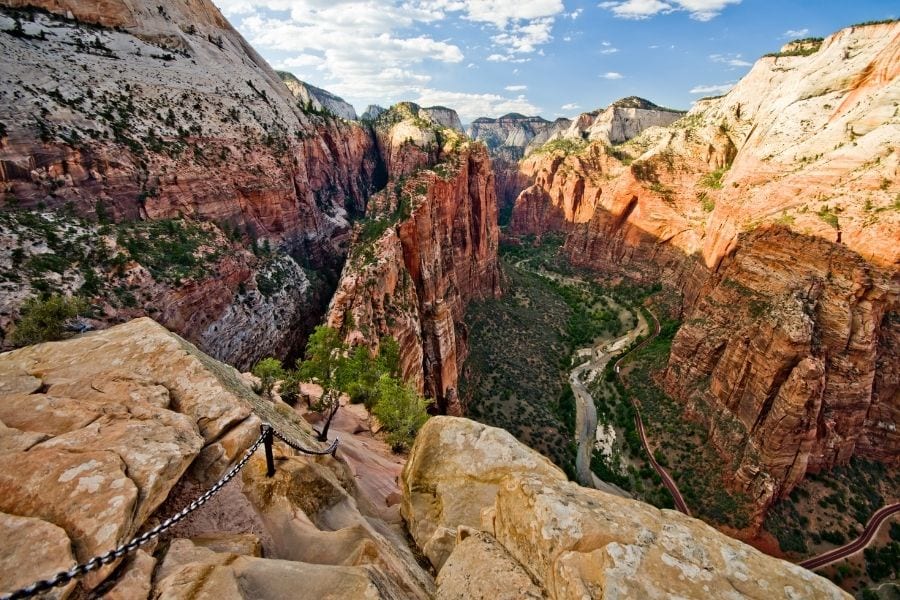
2. Hidden Canyon
Sharing the first part of the trail with Observation Point, the 2.5 mile Hidden Canyon trail splits off after the initial switchbacks. Like Angel’s Landing, the Hidden Canyon trail makes use of chains bolted into the rock wall.
You’ll navigate drop-offs (although not nearly as high as those of Angel’s Landing or Observation Point).
This hike is perfect for those who want an adventurous hike, but aren’t prepared for the dangers (or crowds) of Angel’s Landing.
Important Note
After a major rockfall in 2019, trails in this area are closed until further notice. Closed trails include Observation Point, Hidden Canyon, and Weeping Rock.
3. The Narrows
The other incredibly popular hike in Zion is The Narrows. This trail isn’t actually a trail at all. You’ll wade through the knee-deep Virgin River and observe the canyon it’s carved.
While the official hike is 9.4 miles, many hikers just wade as far as they want upstream before turning back. Make this journey in summer or early fall when water flow is lower and temperatures are warmer.
Because you’ll spend your day with your lower half in water, you’ll need waterproof gear. You can rent river boots, waders, and a walking stick through Zion Outfitter.
Summertime in Zion brings warmer temperatures and thunderstorms. Thunderstorms can cause deadly flash floods in the canyons.
Every hiker should check in with park rangers for trail conditions and the weather forecast before beginning.
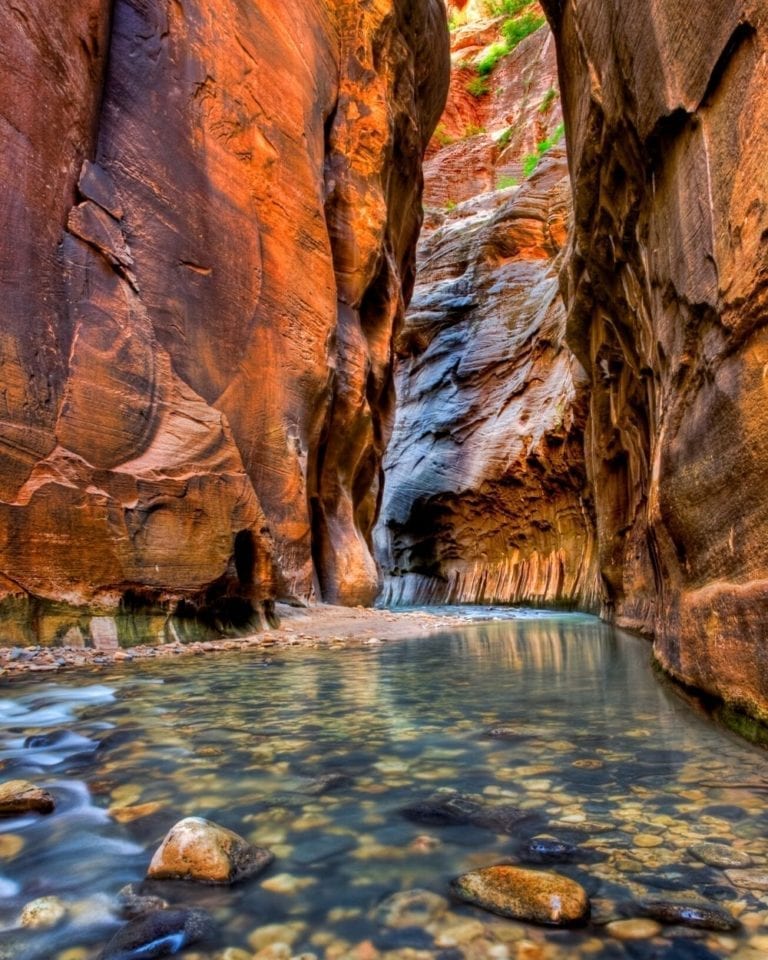
4. Weeping Rock
Less of a hike and more of a viewpoint, the short walk out to Weeping Rock is only 0.2 miles each way. Weeping Rock gets its name from the water that flows through the sandstone.
Once the water reaches an impermeable layer, it’s forced out to the side, resembling tears.
The alcove to Weeping Rock is decorated with lush hanging gardens, made possible by the water streaming down through the canyons.
Important Note
After a major rockfall in 2019, trails in this area are closed until further notice. Closed trails include Observation Point, Hidden Canyon, and Weeping Rock.
5. Observation Point
A less crowded, but more strenuous, alternative to Angel’s Landing is Observation Point. Observation Point stands another 1,000 feet above Angel’s Landing.
As the name implies, the viewpoint is one of the best places in the park to observe the expansive Zion Canyon. From Observation Point, you’re looking south at the entirety of Zion National Park.
Like other trails in the park, it’s important to start early to beat the crowds and avoid a strenuous 2,200-foot climb in the hot summer sun.
Important Note
After a major rockfall in 2019, trails in this area are closed until further notice. Closed trails include Observation Point, Hidden Canyon, and Weeping Rock.
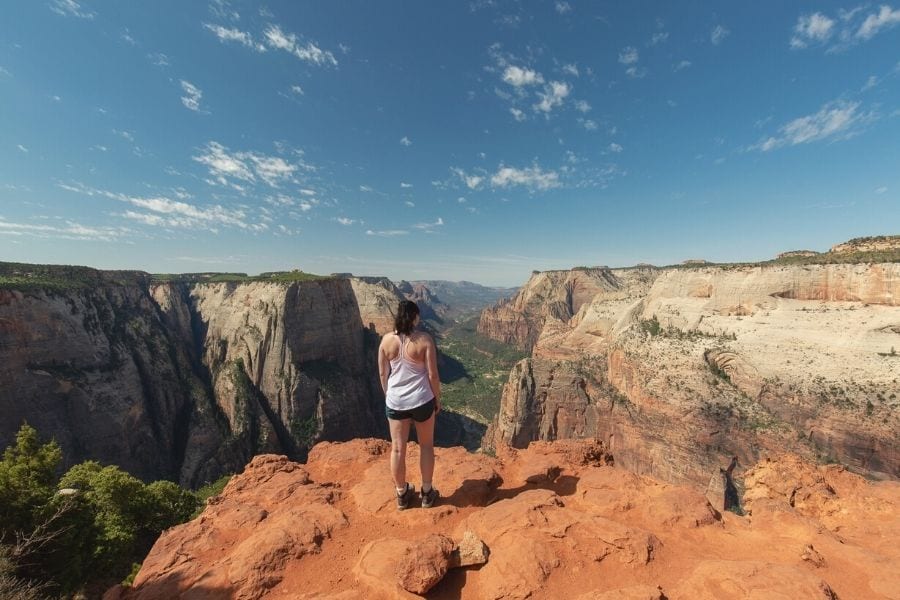
Read More: Hiking Observation Point In Zion National Park
6. Canyon Overlook
The only hike on this list outside of the main Zion Canyon area of the park, Canyon Overlook is a moderate 1 mile round trip trail.
You’ll need a car to get here as the trailhead is on the opposite side of the Zion Mt. Carmel Tunnel on Highway 9, where the park shuttle does not run.
This trail climbs a series of steps before walking atop the steep drop-offs of the Pine Creek slot canyon. Don’t take this 1-mile trail lightly, as the steep drop-offs can be dangerous, especially for young children.
7. Lower Emerald Pools
One of the more family-friendly trails in the park, the 1.2-mile roundtrip trail to Lower Emerald Pools follows a paved path out to a series of cascades.
The Emerald Pools are made up of 3 pools, separated by cascades: the upper, middle, and lower pools.
This trail takes you to the base of the cascades, with limited elevation gain. You’ll see the most water flow in the spring as winter runoff surges.
If you’re looking for more distance, you can add on a hike up to the middle and upper pools for a roundtrip distance of 3 miles. It’s a 200-foot elevation gain, requiring hikers to navigate stairs between the middle and upper pools.
More Things to Do in Zion National Park
While hiking is by far the most popular activity in Zion National Park, there’s more than just hiking. Check out this scenic drive and sunset vista point to round out your trip to Zion.
Drive Zion-Mt. Carmel Highway
This 10-mile drive from the entrance of Zion National Park to the Mt. Carmel junction with Highway 89 is a must. Continue on Highway 9 past the junction with Zion Canyon Scenic Drive.
You’ll gain elevation with steep and windy switchbacks up to Zion-Mt. Carmel Tunnel.
The historic tunnel built in the 1920s has windows for passengers to see the surrounding landscape, but there’s no stopping in the tunnel! Just after exiting the tunnel is the trailhead for the Canyon Overlook hike.
As you continue through the rusty red rocks on Highway 9, keep a lookout for mountain goats that frequent this area.
You’ll see Checkerboard Mesa in the distance – a unique rock formation with vertical cracks from freezing and horizontal cracks from wind erosion.
Sunset at Canyon Junction Bridge
There’s plenty of places to view the sunset in Zion National Park, but one of my favorites is at Canyon Junction Bridge.
The Virgin River in the foreground and The Watchman in the background make for a stunning sunset. If it’s a cloudy night, you could be in for a particularly moody sunset.
Since this bridge is before the Highway 9 junction with Zion Canyon Scenic Drive, you can drive here and await the sunset. I recommend getting there early as there will be many photographers set up with their tripods.
General Tips for Planning a Trip to Zion National Park
- Zion National Park is one of the most popular parks in the country, with over 4.5 million visitors per year. To avoid crowds, visit in shoulder months like April-May or September-October.
- Shuttles and trails are crowded in the afternoons. Start your day early by catching the shuttle into the park between 6 and 7 am.
- Groceries in Springdale are expensive. Stock up on groceries elsewhere, like in St. George, before arriving.
Frequently Asked Questions About Zion National Park
How many days do you need in Zion National Park?
To see the highlights, plan to spend 2 to 3 days in Zion National Park. This gives you time to hike the most popular trails and stop at the scenic viewpoints. To see more, spend at least 5 days in Zion.
What is the best way to see Zion National Park?
The best way to see Zion is to spend several days hiking the most popular trails. In peak season, Zion National Park requires all visitors take the park shuttle that stops at all major trailheads.
What is the best month to visit Zion National Park?
The best months to visit Zion National Park are from March to May or September to November. The shoulder months are less crowded and provide the best weather for hiking.
How do you avoid crowds in Zion National Park?
The best ways to avoid crowds in Zion National Park include visiting on weekdays instead of weekends, starting your day early (before 8 AM), and visiting in the off-season from November to March.
What time should I arrive at Zion National Park?
To beat crowds, arrive at Zion National Park before 9 AM. Parking lots at the visitor center usually fill around this time and lines for the park shuttle can be lengthy by mid-morning.
Final Thoughts on This Guide to Zion National Park
Zion National Park has something for everyone – from families to adventure junkies. This guide to Zion National Park covers all the must-see spots for your trip.
If you’re only in Zion for a few days, don’t miss:
- Angel’s Landing – a strenuous hike with sheer drop-offs and 360-degree views
- The Narrows – a popular hike wading through the knee-deep waters of the Virgin River
- Observation Point – a strenuous elevation gain hike with the best vantage point in the park
- Zion-Mt. Carmel Highway – a 10-mile scenic drive through the historic Zion-Mt. Carmel tunnel
And here’s a few reminders:
- Accommodations are in high-demand near Zion National Park. If you plan to stay in Springdale or Watchman Campground, book 6 months out. If you want a spot at the only in-park lodge, book 13 months out. South Campground accepts reservations two weeks in advance.
- Always carry lots of water. As with any southwestern environment, your sweat evaporates rapidly. Just because you don’t feel sweaty, doesn’t mean you don’t need water. Bring plenty of water on every trail – at least 0.5-1L per hour of hiking
Looking for more ideas for your trip to Zion National Park? Don’t miss these helpful posts!
- Observation Point: Hiking the Observation Point Trail in Zion
- When to Visit: The Absolute Best Time to Visit Zion
- Visit Bryce Canyon: 3-Day Zion & Bryce Canyon Itinerary
- Visit Grand Canyon: 10-Day Zion & Grand Canyon Itinerary
- Utah Road Trip: 8-Day Utah National Parks Itinerary
- All Utah Parks: 14 Best National Parks in Utah
Don’t miss the best of Utah’s national parks on your upcoming trip! This free, printable Utah national park road trip itinerary covers all the best points of interest in all 5 Utah parks, plus bonus tips on where to stay and side trips to nearby state parks and monuments.
Download your free Utah road trip itinerary here.
Don’t Forget to Save This Post on Pinterest
